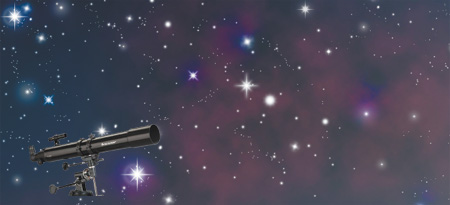
|
CHINA> Astronomical Fans
 |
|
Star trek
By Gan Tian (China Daily)
Updated: 2009-07-21 08:05
 Guo Gang and Zhou Ying are star-struck lovers in every sense of the word. A few years ago the couple's wedding carried an unusual astronomy-theme, which rocketed guests into orbit. Guo was the prince from Sagittarius, his bride was the princess from Scorpio and guests and families were "planets" in the universe. Their Shanghai friends, who also happen to be astronomy fans, called the wedding the social event of the year. But such a star-studded party was to be expected from Guo, who founded the stargazing group Shanghai Phosphor Union. It now has hundreds of members and is one of many of astronomy clubs sprouting all over the country. According to Chinese Astronomical Society there are only 3,000 professional astronomers in China, but the number of astronomy fans cannot be estimated because there are "simply too many". And following China's first ever space walk last year, more people are becoming curious about this subject. But probably nobody can match the passion of the star-crossed couple from Shanghai. Guo and Zhou are expecting their first baby this year and want to ensure the eclipse is recorded in the year of their child's birth. Their car now features a star map, their baby's horoscope, and the logo of International Year of Astronomy 2009. "I will go to see the total solar eclipse somehow, and the magical event can be kept in our family album," says father-to-be Guo, who has been an astronomy fan since he was a high school student. The couple will shoot the pictures in Yangshan Port because it is the "best place for the total solar eclipse, with a time lasting for 5 minutes and 50 seconds," says Guo. They have also hired a photographer specially skilled at nighttime shooting. Meanwhile, a team of 30 students from Peking University are joining students from Shanghai Normal University and Hangzhou Senior High School to share the experience. The Beijing students started the trip on July 18, traveling to observatories in Shanghai, Hangzhou, and Ningbo. They are members of the Youth Astronomy Society (YAS), which was founded on April 20, 1990, when NASA launched the Hubble telescope into space. YAS vice president Liu Boyang, 19, a junior at Department of Astronomy, School of Physics, Peking University, says the society has nearly 1,000 members, and recruits 150 new people each year. One of the ways YAS promotes stargazing is through its "sidewalk astronomy" programs. Members set up a telescope on a footpath and invite passers-by to gaze at the stars in a bid to promote better public understanding of astronomy science. "Some people became astronomy fans in this way, because it was a simple, easy way to arouse their interest in astronomy," says Liu. Last year, two of China's most famous astronomy amateurs visited Beijing to talk to the group, which raised everybody's interest. Chi-Sheng Lin at Lulin Observatory of National Central University in Taiwan, and Ye Quanzhi from Sun Yat-Sen University are famous because they were the first to photograph Comet Lulin on July 11, 2007. "They are not astronomers, but fans," says Liu. "All Chinese astronomy fans call Lin 'the boss' here, and Ye is only a student in Sun Yat-Sen University. They cooperated to find Comet Lulin, which has inspired us a lot." High school students are also joining the solar eclipse celebrations.
Three students from Hangzhou Senior High School have traveled 1,400 km over the past two years following the line of the eclipse. They have developed a map, which points to the best places to watch and has been adopted by International Astronomical Union and other organizations. And don't forget about all those astro boys and girls. Hu Fanglian, a student in Fangcaodi International School, Beijing, has learnt how to draw maps of the universe, recognize stars, and can use a simple telescope thanks to The Hands-On Universe (HOU) program. Launched in China in 2005, the program shows Chinese students how to go online and peer through the telescopes operating in the United States, Japan, Australia, German, and Pakistan. Guo Hongfeng, team leader of China's HOU program, is a senior engineer from the National Astronomical Observatories and in 2004 went to a HOU conference in Russia. She soon discovered the program could be applied in China and now more than 300 students in Beijing's primary and middle schools are involved in the weekly program. "We give some simple projects for students, but they can give us good results," says Guo. During the International Asteroid Search Campaign in 2008, young student Zhou Minchen from Beihang University, found a major asteroid belt, which won IASC committee's praises. Guo and a HOU team of 30 persons are now in Tongling county, Anhui province waiting for the eclipse. And like millions of people around China, their eyes will be reaching for the stars. (China Daily 07/21/2009 page18) |